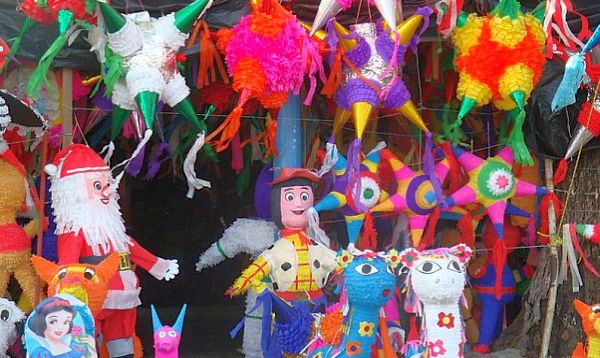Cuautitlán Izcalli, Mexico — On most days, the road from Mexico City to this gritty northern suburb isn’t much to look at. But come Christmas-time, things get a little more festive. Welcome to piñata heaven, where thousands of papier-mâchê donkeys are itching for a jingle-bell beatdown.
For decades, Cuautitlán has been home to some of the most skilled piñateros, men and women who craft these lovable figures and decorate them with colorful ribbons. Parents fill them with candy on Christmas and have their blindfolded children hit them with a stick until they burst, spilling out sugary treats.
Making piñatas emerged as a trade here because the city is rich in clay, which was once used as the piñatas’ main component. Today, however, most of these fixtures are made of papier and cardboard. "The fumes at the clay ovens were dangerous for our health," says José Cruz Sánchez. "And there were some complaints of children getting hurt as they broke the pots."
 |
Cruz makes piñatas on a narrow street just off the highway. His entire family is in the piñata business, too. Two small shops serve as the front end of what seems to be the Cruz family’s smooth-running production facility. The floor of a small atrium behind the stores is covered in papier, where hundreds of unfinished piñatas are waiting to get the finishing touches.
Nearby, on top of a fire, rests a large cauldron filled with hot bubbling glue. "On average, we sell around 50,000 piñatas every year," Cruz says. "We work all year to have enough of them finished by the time the Christmas holidays start. Mexicans can’t celebrate Christmas without their piñatas."
In Cuautitlán, piñatas are sold in various shapes and sizes (they’re not all donkeys.) Some are as small as a softball, while others are 7 feet tall and resemble giant spiders. The most widely sold piñatas are shaped like seven-pointed stars, while other popular types look like papier-mâché cartoon characters. Prices range from as little as $1.50 to as much as $30.
The origins of the piñata here can be traced back to Europe and pre-Columbian Mexico. In the 16th century, Europeans brought a piñata-like tradition across the Atlantic, where it fused with a similar indigenous practice and became a religious symbol. The points of the papier-mâché star represent the seven deadly sins, and the candy inside represents the temptations of Satan. Today, these Christian symbols have mostly lost their meaning in favor of family fun - piñatas are a favorite at children’s birthday parties - and most are still made according to classic design.
The city’s piñateros take pride in their work. They say they are one of the last communities in the area where piñatas are still made by hand. "It’s not very hard to make a piñata in a factory, but we still do it with dedication and skill. That’s why people love our piñatas," says Alex Caballero, who runs a store next to the Cruz family workshop. "They come from all over the country to buy them, sometimes even from abroad. The other day we had a guy from Canada who wanted a whole bunch of them."
And though the capital city is being flooded with cheap copies made in China, Caballero isn’t worried these knockoffs will threaten Cuautitlán’s piñata business. "It is still largely a family business and a tradition," he says. "We deliver quality. No cheap copy can compete with that."
Original Story


